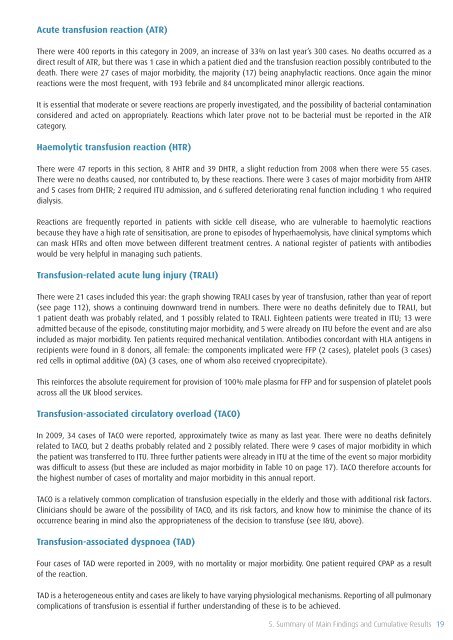SHOT Annual Report 2009 - Serious Hazards of Transfusion
SHOT Annual Report 2009 - Serious Hazards of Transfusion
SHOT Annual Report 2009 - Serious Hazards of Transfusion
Create successful ePaper yourself
Turn your PDF publications into a flip-book with our unique Google optimized e-Paper software.
Acute transfusion reaction (ATR)<br />
There were 400 reports in this category in <strong>2009</strong>, an increase <strong>of</strong> 33% on last year’s 300 cases. No deaths occurred as a<br />
direct result <strong>of</strong> ATR, but there was 1 case in which a patient died and the transfusion reaction possibly contributed to the<br />
death. There were 27 cases <strong>of</strong> major morbidity, the majority (17) being anaphylactic reactions. Once again the minor<br />
reactions were the most frequent, with 193 febrile and 84 uncomplicated minor allergic reactions.<br />
It is essential that moderate or severe reactions are properly investigated, and the possibility <strong>of</strong> bacterial contamination<br />
considered and acted on appropriately. Reactions which later prove not to be bacterial must be reported in the ATR<br />
category.<br />
Haemolytic transfusion reaction (HTR)<br />
There were 47 reports in this section, 8 AHTR and 39 DHTR, a slight reduction from 2008 when there were 55 cases.<br />
There were no deaths caused, nor contributed to, by these reactions. There were 3 cases <strong>of</strong> major morbidity from AHTR<br />
and 5 cases from DHTR; 2 required ITU admission, and 6 suffered deteriorating renal function including 1 who required<br />
dialysis.<br />
Reactions are frequently reported in patients with sickle cell disease, who are vulnerable to haemolytic reactions<br />
because they have a high rate <strong>of</strong> sensitisation, are prone to episodes <strong>of</strong> hyperhaemolysis, have clinical symptoms which<br />
can mask HTRs and <strong>of</strong>ten move between different treatment centres. A national register <strong>of</strong> patients with antibodies<br />
would be very helpful in managing such patients.<br />
<strong>Transfusion</strong>-related acute lung injury (TRALI)<br />
There were 21 cases included this year: the graph showing TRALI cases by year <strong>of</strong> transfusion, rather than year <strong>of</strong> report<br />
(see page 112), shows a continuing downward trend in numbers. There were no deaths definitely due to TRALI, but<br />
1 patient death was probably related, and 1 possibly related to TRALI. Eighteen patients were treated in ITU; 13 were<br />
admitted because <strong>of</strong> the episode, constituting major morbidity, and 5 were already on ITU before the event and are also<br />
included as major morbidity. Ten patients required mechanical ventilation. Antibodies concordant with HLA antigens in<br />
recipients were found in 8 donors, all female: the components implicated were FFP (2 cases), platelet pools (3 cases)<br />
red cells in optimal additive (OA) (3 cases, one <strong>of</strong> whom also received cryoprecipitate).<br />
This reinforces the absolute requirement for provision <strong>of</strong> 100% male plasma for FFP and for suspension <strong>of</strong> platelet pools<br />
across all the UK blood services.<br />
<strong>Transfusion</strong>-associated circulatory overload (TACO)<br />
In <strong>2009</strong>, 34 cases <strong>of</strong> TACO were reported, approximately twice as many as last year. There were no deaths definitely<br />
related to TACO, but 2 deaths probably related and 2 possibly related. There were 9 cases <strong>of</strong> major morbidity in which<br />
the patient was transferred to ITU. Three further patients were already in ITU at the time <strong>of</strong> the event so major morbidity<br />
was difficult to assess (but these are included as major morbidity in Table 10 on page 17). TACO therefore accounts for<br />
the highest number <strong>of</strong> cases <strong>of</strong> mortality and major morbidity in this annual report.<br />
TACO is a relatively common complication <strong>of</strong> transfusion especially in the elderly and those with additional risk factors.<br />
Clinicians should be aware <strong>of</strong> the possibility <strong>of</strong> TACO, and its risk factors, and know how to minimise the chance <strong>of</strong> its<br />
occurrence bearing in mind also the appropriateness <strong>of</strong> the decision to transfuse (see I&U, above).<br />
<strong>Transfusion</strong>-associated dyspnoea (TAD)<br />
Four cases <strong>of</strong> TAD were reported in <strong>2009</strong>, with no mortality or major morbidity. One patient required CPAP as a result<br />
<strong>of</strong> the reaction.<br />
TAD is a heterogeneous entity and cases are likely to have varying physiological mechanisms. <strong>Report</strong>ing <strong>of</strong> all pulmonary<br />
complications <strong>of</strong> transfusion is essential if further understanding <strong>of</strong> these is to be achieved.<br />
5. Summary <strong>of</strong> Main Findings and Cumulative Results 19












